|
MARQUIS DE LAFAYETTE
|
|
Marble bust of Lafayette, one of several executed by Jean-Antoine Houdon between 1785-89. (This one is now at the Virginia State Library and Archives, Richmond.)
|
Marie Joseph Paul Yves Roch Gilbert du Motier, Marquis de Lafayette (1757- 1834)
|
|
The Lafayette [La Fayette] family was of ancient nobility, an ancestor served as a marshal of France under Charles VII in the Hundred Years' War. Gilbert du Motier was only two years old when his father had been killed in the Seven Years' War. At sixteen, he inherited his title and a large fortune from his grandfather.
Lafayette was a junior officer in the French army when in 1777, popular narratives have the nineteen year old marquis defy his family and the orders of the King Louis XVI, and sail to the American colonies to serve as a Major General in the American Continental Army. This dramatic description of his "defying the king's orders" to depart from France is based upon Lafayette's memoirs, and must be carefully examined when one also recognizes that same memoirs express that Lafayette owes much to the comte de Broglie in executing his project. Left unsaid in the marquis' memoirs are the specifics of the count's involvement. As it happens, comte de Broglie-Ruffec was captain Lafayette's senior commander when the young, impressionable marquis was with the French army on summer maneuvers at Metz. It was there that comte de Broglie hosted a dinner on 8 August 1777, and where Lafayette witnessed the honored dinner guest, The Duke of Gloucester (brother to England's King George III) speak favorably of the American insurgents' cause and how unwise was the British policy to attempt to suppress the rebellion. In his memoirs, Lafayette identified this as the moment he decided to join the American revolutionaries.
In contrast, comte de Broglie had had a long interest in the brewing, and then open rebellion of the North American English colonies. De Broglie was involved as early as 1775 with the secret support of arms and deployment of volunteer French officers to serve in the Continental army. It was de Broglie's subordinates who organized and arranged for the purchase of Lafayette's ship, which the marquis could not purchase directly due to his young age. De Broglie was responsible for La Fayette's association with de Kalb, a highly experienced officer in the French army, and who played a significant role in preparing Lafayette for America.
Once Lafayette reached Philadelphia, at the end of July 1777, it was fortunate that he had the wealth to volunteer to serve in the American army at his own expense; and at age 20, received the rank of Major General from Congress. His date of rank was 7 December 1776, when he signed up with the American representative in Paris. [This appears to make the marquis the youngest commissioned regular general officer in the US Army.] Lafayette served in the battle of Brandywine (11 Sep 77, where he was wounded). In November of 1777, he led his first independent command of a small reconnaissance force at Gloucester, NJ, and got the better of a skirmish against some Hessians. He had a command at White Marsh (5-8 Dec 77). During this period, George Washington took a strong, personal liking to the young Frenchman, who in turn held the American commander in high admiration.
In December 1777, Lafayette received command of Virginia light infantry. He began the winter of 1777-78 at Valley Forge, but was sent to Albany, NY, to prepare for an invasion of Canada. The invasion was canceled and he returned to Valley forge, where he again succeeded in a small operation at Barren Hill (May 78). Lafayette performed with distinction at the battle of Monmouth (28 Jun 78). He commanded two brigades near Newport, RI, (Jul-Aug 78) in the failed, first Franco-American allied operation of the war.
In January 1779, Lafayette returned to France, with some anticipation that he would be invovled with an outbreak of combat in Europe. However, when the French Foreign Minister decided to further support operations in North America, Lafayette was able to contribute valuable insight in for the early planning of the French military expedition to North America. He returned to the US in April 1780, before the arrival of Rochambeau's military expedition in July. Washington sent Lafayette, in command of American troops, to Virginia to counter Benedict Arnold. The young Marquis ended up facing off against the much larger force of Cornwallis. In this Virginia Campaign of April-August 1781, Lafayette proved to be a good strategist in avoiding defeat while harassing his formidable opponent to withdraw to Yorktown for reinforcements. [See link to 'Lafayette's Virginia Campaign' webpage at end of this page.] Lafayette commanded his American brigade at the siege of Yorktown (September 1781), and departed for France in December 1781.
|
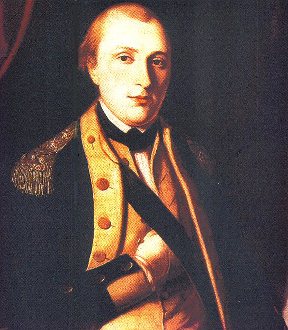 |
Charles Wilson Peale's oil-on-canvas portrait of Lafayette (to the left, wearing an American major general's uniform) was commissioned by George Washington, and was hung at Mount Vernon, side-by-side with C.W. Peale's 1772 portrait of Washington. Both paintings are now at Washington & Lee University, Lexington, Virginia.
Reportedly, Lafayette announced to Washington in summer of 1777 as he reported for duty, "I am here to learn, not to teach." Evidently he learned well.
|
|
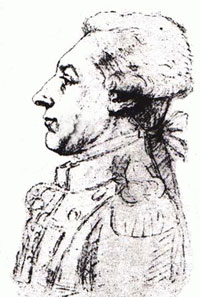
Lafayette (c. 1790), sketched by Duvuvier, exhibits the steeply slanted forehead reflected in the Houdon bust (top of page). (Sketch is in French archives.)
|
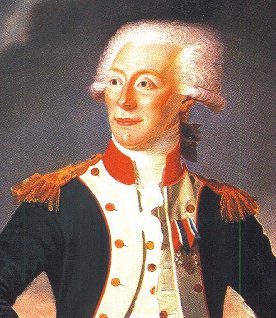
Lafayette (c. 1790), painted by French artist Joseph Boze. Work is held by the Massachusetts Historical Society, Boston. The uniform is of a general of the Paris National Guard, which he commanded from 1789 to 1791.
|
|
|
When he returned to France in January 1782, Lafayette was famous -- 'a hero of two worlds'. Lafayette and his wife established themselves in a Paris town-home on rue de Bourbon, which, as �H�tel de La Fayette', became an active �salon' visited by many Americans and European intellectuals. Lafayette and his wife became very active in �Soci�t� des amis des Noirs' that advocated ending the slave trade and granting full rights to free Africans in Europe and North America.
In late 1784, he returned briefly to the United States to visit George Washington at Mount Vernon. The 20th century painting below [in a private collection] depicts this only time Lafayette visited Mount Vernon when Washington was also present. It was also their last time together.

Returning to France, Lafayette tried, but was unable to influence a more moderate course in the French revolution. He became active in politics in France,
received many honors, and was made commander of the Paris National Guard in 1789. In 1791 Lafayette's moderate political views began to lose out to the extreme political factions of Royalists [Orl�anists] and Jacobin radicals. Lafayette left Paris in October 1791 to live in his ancestral home, Chavaniac, in the Haute-Loire.
In 1792, when France was attacked by the Austrian led European coalition, Lafayette was given command of the French Revolution Army of the Center in 1792. As with other noblemen who still served the Revolution, Lafayette had cause to fear the Jacobin factions that had taken control of French politics, and he fled to Belgium. However, the Austrians considered Lafayette the cause of the anti-monarchial revolt in France and imprisoned him (one year at Magdeburg, and four years at Olm�tz). Lafayette's wife, Adrienne, was placed under house arrest at Chavaniac in late 1792; then during 'the Reign of Terror' she was moved to prisons in Paris in 1794. With the July 1794 overthrow of Robespierre the Reign of Terror ended and with the assistance of Americans such as Gouverneur Morris and James Monroe, Adrienne was released from prison. She arranged for her son, Georges to be sent to the United states, while she took her other children, Anastasie and Virginie, and joined Lafayette in his prison at the Olm�tz fortress in October 1795. On 18 September 1797, the family was released, under the terms of the treaty of Campo-Formio (that would be concluded by Napoleon one month later and ended the French war with Austria in Italy).
In 1799, Lafayette and his family moved to The Netherlands. Lafayette's status as an �migr� kept him in exile, but Adrienne returned to France, where she successfully recovered much of the families properties, including from her mother's estate, la Grange. Adrienne succeeded in March 1800, to have Napoleon remove Lafayette's name from the �migr�s list, allowing the Marquis' return to France. Lafayette and his wife took up residence at la Grange. Adrienne had become chronically ill -- suspected due to lead poisoning -- and she died 24 December 1807. She was buried at the Picpus cemetery, which she had made a special memorial upon discovering it to be the burial place of her relatives and other victims of the Terror.
While he acknowledged Bonaparte's position, Lafayette declined to accept any role in the Emperor's regime and refused the Legion d'Honor. After Napoleon's fall, Lafayette remained active, but continuously lost influence in French politics. For a time he was an elected member of the Chamber of Deputies. However, his political philosophy was too simplistic for the complexities that faced France. He was not destined to contribute as much to France as he did to the United States in those nations' respective quests for political freedom. His most significant legacy has been as a symbol for a tradition of continuing French and American friendship.
 Lafayette continued to maintain strong ties with his associates of the American Revolution. He made an extensive visit to the United States in 1824-25. It is uncertain if Lafayette returned from this trip to France with barrels of American soil, or wether he later ordered such to be sent to him in France, for the purpose that it be placed around his casket. He and his wife, Adrienne de Noailles, are buried in Le Jardin de Picpus cemetery, Paris. Since after World War I, an American flag has been at his grave site. It remained there, undisturbed, during the German occupation in World War II. The flag has been there since there was a Sons of the American Revolution Chapter in France (1897). It may have been there even earlier, and there is no record of its temporary removal. Lafayette continued to maintain strong ties with his associates of the American Revolution. He made an extensive visit to the United States in 1824-25. It is uncertain if Lafayette returned from this trip to France with barrels of American soil, or wether he later ordered such to be sent to him in France, for the purpose that it be placed around his casket. He and his wife, Adrienne de Noailles, are buried in Le Jardin de Picpus cemetery, Paris. Since after World War I, an American flag has been at his grave site. It remained there, undisturbed, during the German occupation in World War II. The flag has been there since there was a Sons of the American Revolution Chapter in France (1897). It may have been there even earlier, and there is no record of its temporary removal.
Lafayette: US Citizen.
In late July 2002, the US Congress voted to make Lafayette an honorary Citizen of the United States. This particular honor places Lafayette among only five others who were similarly honored: Winston Churchill, Mother Teresa, Raoul Wallenberg, and Pennsylvania founder William Penn and his wife Hannah.
While this dignity signals a collective twenty-first century awareness of Lafayette's contribution to the Nation, historians are reminded that Lafayette had already been made a citizen of Maryland (1785) and of New York City (1784). Therefor, Lafayette effectively became a US Citizen when Maryland became a state in the formation of the new �United States'. This issue is addressed in Louis Gottschalk's Lafayette Between the American and French Revolution (1950); Appendix III and pages 145-47 of the main text.
|
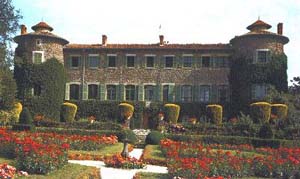
|
Château de Chavaniac (left) in Haute-Loire, was Lafayette's birthplace and boyhood home, to which he returned at times during his life. It is now a museum open to the public.
|
|
|
Ch�teau de la Grange-Bl�neau (right) 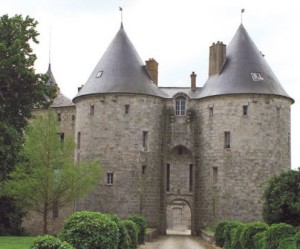 came to Lafayette family from Adrienne's inheritance. Lafayette lived there from 1802 until his death in 1834. The chateau, located in the commune of Courpalay, in the Seine-et-Marne d�partement of France, dates from the 14th century. Its five circular towers were added in the 15th century, and the structure was further altered in the 17th century. The castle has been untouched since Lafayette's death. In 1955, a descendant of Lafayette, Ren� de Chambrun, obtained possession of the chateau and discovered a large cache of documents in the attic. Today, the chateau is the property of the Jos�e and Ren� de Chambrun Foundation, a charitable foundation charged with preserving the castle and its historical contents. came to Lafayette family from Adrienne's inheritance. Lafayette lived there from 1802 until his death in 1834. The chateau, located in the commune of Courpalay, in the Seine-et-Marne d�partement of France, dates from the 14th century. Its five circular towers were added in the 15th century, and the structure was further altered in the 17th century. The castle has been untouched since Lafayette's death. In 1955, a descendant of Lafayette, Ren� de Chambrun, obtained possession of the chateau and discovered a large cache of documents in the attic. Today, the chateau is the property of the Jos�e and Ren� de Chambrun Foundation, a charitable foundation charged with preserving the castle and its historical contents.
|
|
![[Portrait]](laf-old.jpg) |
Lafayette by French painter, Ary Scheffer. Work is in US Capitol Collection. Many copies were made for Lafayette's 'farewell tour' of the United States (1824-25).
|
|
 |
Lafayette's Coat of Arms
|
|
Suggested webpage links:
- The Lafayette Collection at Cornell University.
- Guide, biographical summary, and images from the leading archive of documents concering Lafayette's life and career.
- The site is extensive, so be sure to visit the portion that celebrates the 250th anniversary of Lafayette's birth at:
http://rmc.library.cornell.edu/lafayette/exhibition/english/introduction/index.html
- The American Friends of Lafayette website.
- This is an historical and patriotic society dedicated to the memory of Marquis Gilbert Motier de Lafayette.
- Website on Lafayette and Slavery.
- Remarkable and very well structured series of webpages sponsored by Skillman & Kirby Libraries, Lafayette College .
- Website for Ch�teau-mus�e Lafayette.
- Ch�teau-mus�e Lafayette is at Chavaniac in Haute-Loire of the Auvergne, France.
- Hermione Project.
- Learn about the current rebuilding of the frigate that brought Lafayette to American in 1780. The project is taking place in Rochefort, France.
- Cleveland State University Library's website celebrating the Marquis de Lafayette.
- Cleveland State University Library holds several significant special collections, including a copy of the Lafayette Microfilm Collection of papers in 1956 by the late Count Ren� de Chambrun, a direct descendant of Lafayette, in the tower at Chateau La Grange, located approximately 30 miles east of Paris. Presently, Cleveland State and The Library of Congress in Washington, D.C. are the only two locations in North America where the microfilm collection may be consulted. The papers found at La Grange are not the whole of the Lafayette family papers. Many of Lafayette's papers were removed during the nineteenth century to Chavaniac, a family estate located in the Auvergne region of France, and eventually acquired by Cornell University in 1964 [See link above].
- Lafayette's May 1778 military operation at Barren Hill,
- Describes, with maps, this incident that took place between Valley Forge and Philadelphia, PA. Map details are based upon contemporary maps by Michel Capitaine du Chesnoy, Lafayette's cartographer. The latter can be viewed on the Internet at the US Library of Congress website collection 'The American Revolution and Its Era, Maps and Charts of North America and the West Indies'. URL is http://memory.loc.gov/ammem/gmdhtml/armhtml/armhome.html.
- Lafayette's Virginia Campaign of 1781.
- Prelude to, and essential part of the Yorktown Campaign.
- Expédition Particulière Lafayette monuments webpage.
- An attempt to identify the status of some of the many monuments to Lafayette.
- La Fayette's Ocean Crossings.
- A summary of the four trips the Marquis made between France and the United States, identifying the particular ships and ports involved.
- La Fayette's Visits to Mount Vernon.
-
- Lafayette's 1784 Return Visit to The United States.
- The Marquis' First Visit to The United States After the American Revolution, and his second visit to Mount Vernon � the only time when Lafayette and George Washington were at Mount Vernon together.
- Issue of Washington's Masonic Apron Gift from Lafayette.
-
- The Tree That Hides the Forest.
- This paper argues persuasively to put Lafayette's contribution in the American War for Independence in to proper context. Though well meaning in efforts to elevate Lafayette's image in American memory, many narrative histories portray the Marquis' role as a singular initiative. This narrow perspective ignores the fact that the essential environment for the young French nobleman's participation had been created and was sustained by the initiatives of the senior French authorities.
- The Broglie 'French Connection' and the Planned Invasion of England.
- This page provides more detail on the remarkable schemes of Charles Fran�ois, comte de Broglie and marquis de Ruffec.
- Lafayette in the American Revolution.
- Lafayette's narrative of his service with the American army during the Revolutionary War, as described in his Memoirs.
- The Decision to Send a French Military Expeditionary Force, website.
- Many narratives on Lafayette's accomplishments attributed to Lafayette an exaggerated role in persuading the French authorities to send a military expedition to serve with the American continental army in 1780. This page addresses the that decision with more perspective.
- Marquis de Lafayette Chapter, Sons of the American Revolution, website.
-
|
|
|
|
|
|

|
Return to
Expédition Particulière
page.
|
|
|
Page last revised 24 November 2011.
|
|
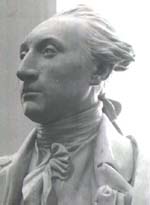






 came to Lafayette family from Adrienne's inheritance. Lafayette lived there from 1802 until his death in 1834. The chateau, located in the commune of Courpalay, in the Seine-et-Marne d�partement of France, dates from the 14th century. Its five circular towers were added in the 15th century, and the structure was further altered in the 17th century. The castle has been untouched since Lafayette's death. In 1955, a descendant of Lafayette, Ren� de Chambrun, obtained possession of the chateau and discovered a large cache of documents in the attic. Today, the chateau is the property of the Jos�e and Ren� de Chambrun Foundation, a charitable foundation charged with preserving the castle and its historical contents.
came to Lafayette family from Adrienne's inheritance. Lafayette lived there from 1802 until his death in 1834. The chateau, located in the commune of Courpalay, in the Seine-et-Marne d�partement of France, dates from the 14th century. Its five circular towers were added in the 15th century, and the structure was further altered in the 17th century. The castle has been untouched since Lafayette's death. In 1955, a descendant of Lafayette, Ren� de Chambrun, obtained possession of the chateau and discovered a large cache of documents in the attic. Today, the chateau is the property of the Jos�e and Ren� de Chambrun Foundation, a charitable foundation charged with preserving the castle and its historical contents.
![[Portrait]](laf-old.jpg)

